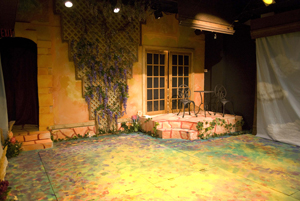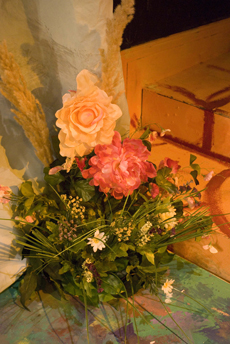
The magic words in Patrick Barber's adaptation of Elizabeth Von Arnim's Enchanted April are "sunshine and wisteria"— the romantic prospect thereof spurring four Englishwomen to flee the gloom of their native Hampstead in 1922 for an Italian holiday that will forever change their lives. Wisteria is no domesticated back-yard bloom, however, but sturdy-trunked garden foliage demanding very specific meteorological conditions — among them, full sunshine for six weeks.
This means that a quick trip to a Chicago neighborhood florist is unlikely to bring forth wisteria, live or artificial — so how did Idle Muse, a small storefront theater company with a likewise restricted budget, secure this rare blossom evoking ecstatic anticipation in the pilgrims who follow its call to seek the light?
"Enchanted April is a memory piece," says scenic designer Dennis Mae, "and as such, invites illusion, and abstraction, over strict realism. Evan [Jackson], our director, mentioned to me at an early conference that he wanted to incorporate Impressionism into the visual scheme, but he also wanted it to be a collaborative effort, evolving slowly, with all of the company members contributing their ideas. Wisteria wasn't even a consideration at that point."
Lottie, who narrates the story, names several other kinds of flowers growing on the estate, leading some productions of this play to flood their stages with strings and clusters of generic flora, like party decorations at a luau. How did this one specific element become so important?
 "My first vision was of impressionistic spring landscapes," Mae recalls, "but that winter, I'd assigned the play as a project for one of my design classes, and the students had brought in scores of photographs showing wisteria boughs and canopies." He sighs, "So when [production manager] Tristan Brandon called for some modifications in my original concept, I decided that we needed some 3-D wisteria to anchor Evan's wish for a tangible, interactive world — as opposed to merely an 'impression' of wisteria."
"My first vision was of impressionistic spring landscapes," Mae recalls, "but that winter, I'd assigned the play as a project for one of my design classes, and the students had brought in scores of photographs showing wisteria boughs and canopies." He sighs, "So when [production manager] Tristan Brandon called for some modifications in my original concept, I decided that we needed some 3-D wisteria to anchor Evan's wish for a tangible, interactive world — as opposed to merely an 'impression' of wisteria."
In the final staging, the "3-D" wisteria is seen only on a trellis and hanging from the patio rafters, surrounded by a dappled multi-hued floor suggesting beds of ground flowers — iris, pansies, snapdragons, etc.— and wisteria-blue curtains representing walls covered in climbing vines.
"Real flowers would have been prohibitive, but after searching, I found some high-quality artificial wisteria made in China, and, luckily, a wholesaler in Florida with a stock of it — import costs being likewise prohibitive — though the six dozen stems we wound up ordering almost broke our bank."
Considering the religious fervor with which the characters speak of them, that's a lot of enchantment invested in these horticultural icons. Mae concurs, "Painted flowers alongside silk flowers clash, ruining whatever effect either could achieve alone, and too many flowers, of any kind, would have competed with them. So we gave wisteria the pride of place at upstage center, thus keeping the focus where it belongs."
Mary Shen Barnidge
Contributing Writer

 Follow Us On Twitter
Follow Us On Twitter